Time:2020-07-10 Reading:18699
Similar to
colorful flowers, butterflies, chameleons, and other animals often display vibrant
colors, although there are differences between these two phenomena. The colors
of flowers mainly come from pigments, where pigments absorb or reflect specific
wavelengths of light to produce colors. On the other hand, the colors of
butterflies or chameleons originate from subtle structures on their bodies,
such as nano "photonic crystals" (PC), which involve light
scattering, diffraction, and interference. This phenomenon is known as
"structural color." Structural color offers various advantages, such
as resistance to fading, water washing, and adjustable colors. However,
achieving structural color conveniently and efficiently through currently
popular 3D printing technology is still not feasible.
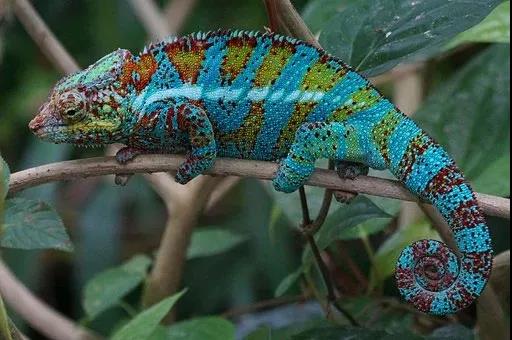
Recently, the research group led by Ying Diao at the University of Illinois Urbana-Champaign (UIUC) in the United States published a paper in the journal Science Advances, demonstrating the 3D printing of vibrant structural colors using only one type of "ink." The crucial aspect of this work lies in the use of a polymer material known as "bottlebrush copolymer" in their "ink."
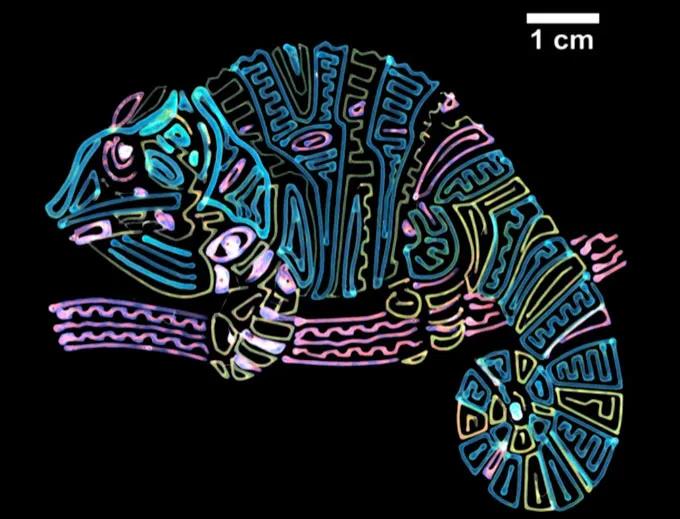
3D printing of
a colorful chameleon image. Image
source: Sci. Adv.
"Bottlebrush
copolymer" is a type of branched or grafted polymer with high grafting
density side chains attached to the main chain backbone, resembling the shape
of a bottlebrush. Due to its unique structure, it can form complex but highly
ordered materials. By controlling the selection of monomers and the synthesis
process, it allows for the design and fabrication of "DIY nanomaterials"
with specific size, shape, and composition. As a result, it has broad research
and application potential in various fields, such as surfactants, photonic
crystals, coatings, and nanomedicine.
Schematic
diagrams of three "bottlebrush copolymers." Image source: Chem. Soc. Rev. [1]
The researchers
used ring-opening metathesis polymerization (ROMP) to synthesize
bottlebrush-shaped graft copolymers PDMS-b-PLA. In this copolymer,
polydimethylsiloxane (PDMS) and polylactic acid (PLA) each accounted for 50% of
the composition, and gel permeation chromatography (GPC) analysis showed a
narrow molecular weight distribution.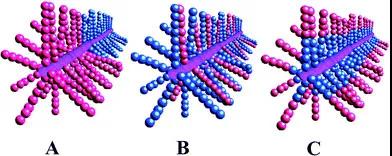
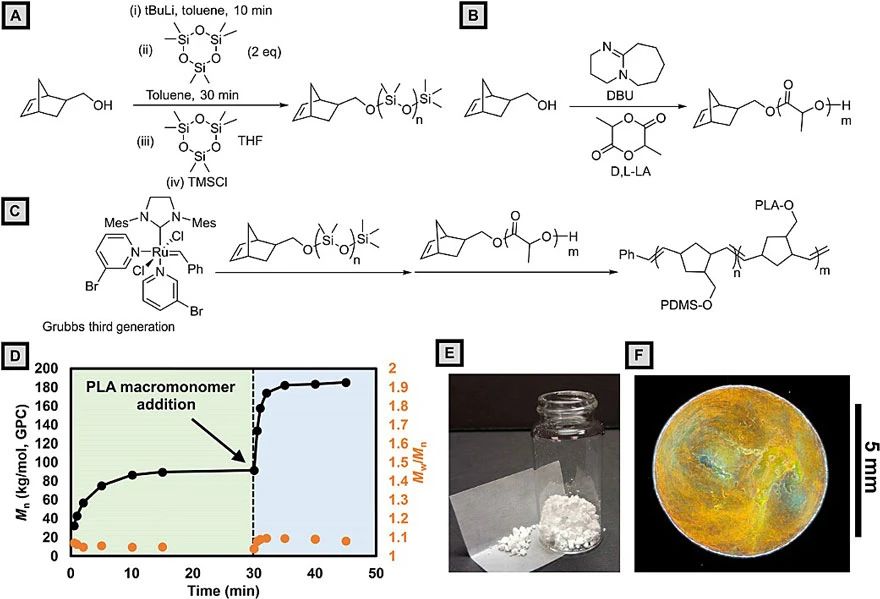
Preparation of
PDMS-b-PLA bottlebrush copolymer. Image
source: Sci. Adv.
The copolymer
white solid powder (Figure E) was dissolved in tetrahydrofuran (THF) to prepare
a solution with a concentration of 100 mg/mL, which served as the required
"ink" for printing. In the solution, the branched chains of the
bottlebrush polymer entangled with each other, forming micelles. When the
solution was drop-cast to form a film, the solvent evaporated, causing
microphase separation between polymer molecules, resulting in an ordered
layered structure and leading to significant random colors.
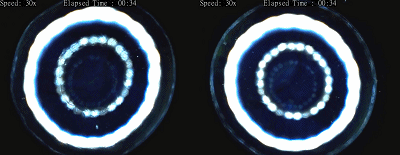
“Colorful thin films formed after drying the 'bottlebrush copolymer' solution”. Image source: Sci. Adv.
The bottlebrush
copolymer can exhibit a wide range of vibrant colors, which can be controlled
by adjusting the printing speed, applied pressure, and substrate temperature.
In other words, these factors influence the polymer's microphase separation
process. The researchers loaded the 'ink' into a 3D printer and, under a
pressure of 30 kPa, obtained a two-dimensional color matrix by varying the
substrate temperature (25 °C, 50 °C, and 70 °C) and printing speed (15 to 480
mm/min). The printed lines displayed consistent colors. However, slight color
variations were observed at the beginning of printing and around corners
(Figure C)."
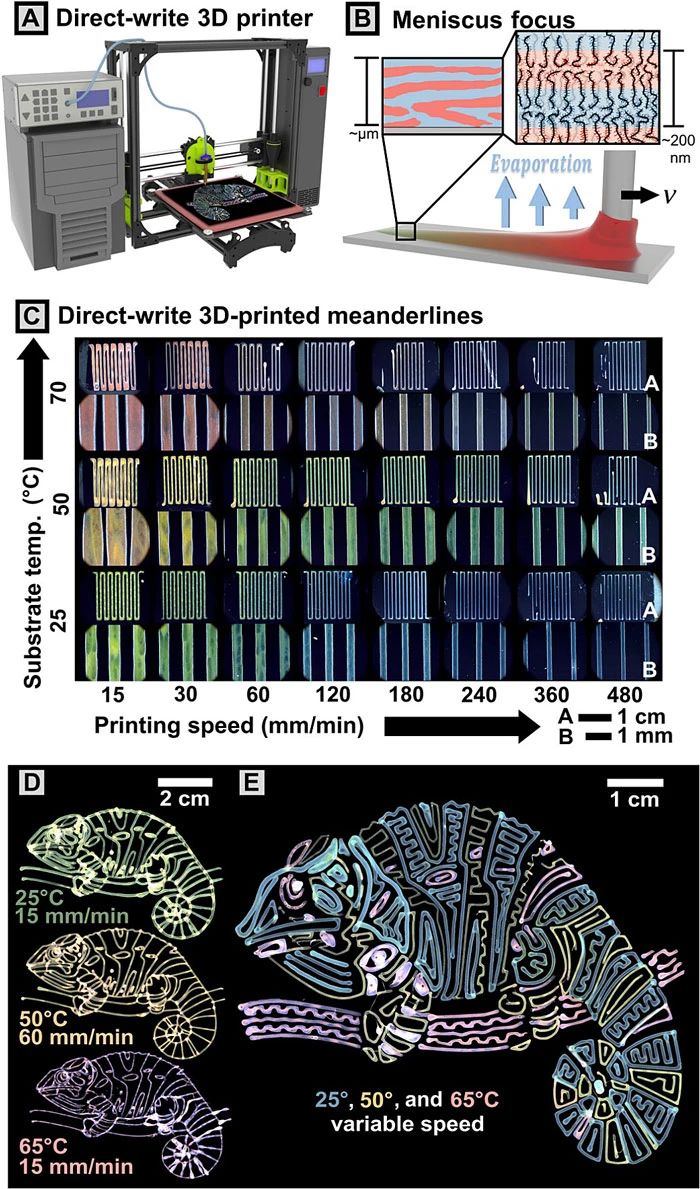
3D printing
complex structural colors. Image
source: Sci. Adv.
The 3D printed
structural colors exhibit a wide range, ranging from blue light at 403 nm to
red light at 626 nm. By programming the 3D printer, more intricate patterns can
be achieved. The researchers printed three different-colored chameleons (Figure
D) and a chameleon with three colors on a silicon wafer by adjusting the
printing speed, pressure (35 kPa), and temperature (Figure E).
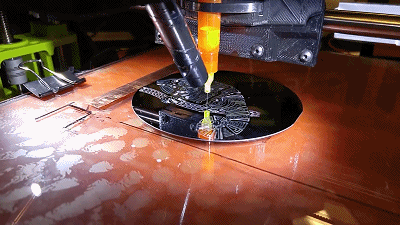
3D printing
complex structural color patterns.
Image source: Sci. Adv.
With the
increase in printing speed, a significant blue shift in the reflected
wavelength is observed, while higher temperatures cause a noticeable red shift.
Through SEM and SAXS characterization, the color variations result from the
different domain spacings in the printed layered thin films. The changes in
domain spacing are attributed to the "head-to-head" arrangement of
the bottlebrush copolymer molecules, meaning that each structural unit consists
of a double layer, and the layer backbone exhibits significant elasticity. The
variation in domain spacing is caused by the expansion and compression of the
molecules.
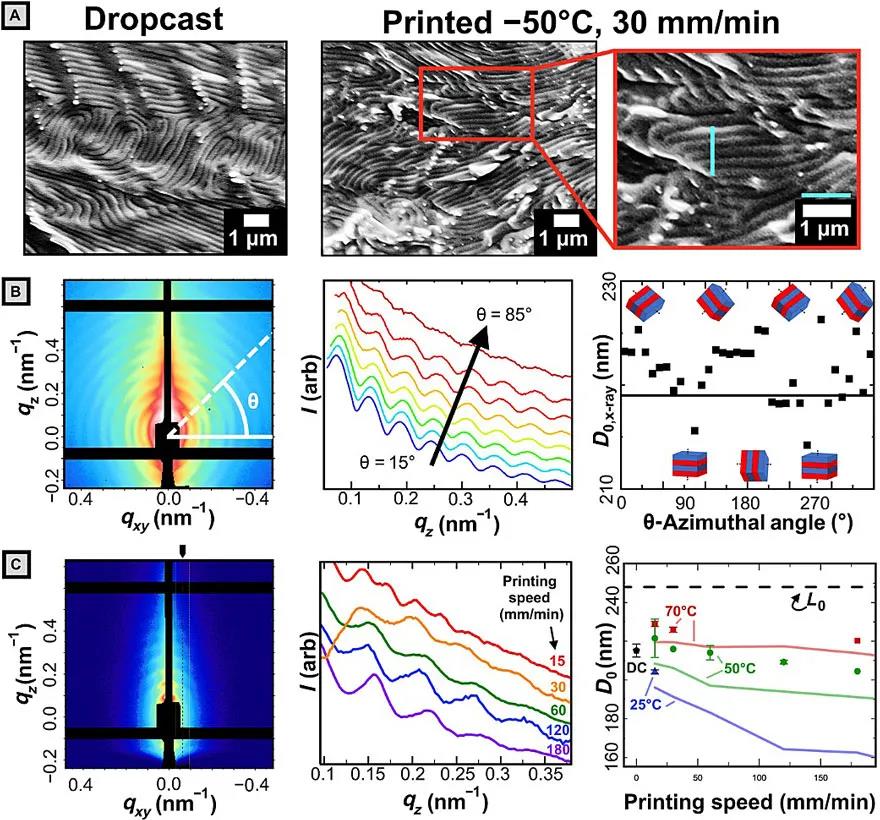
Microscopic
structural characterization. Image
source: Sci. Adv.
"Utilizing
polymers to achieve these vivid colors and applying them in eco-friendly
coatings and highly selective optical filters pose a challenge," says Ying
Diao. "Accurate control of polymer synthesis and processing is required to
form ultra-thin ordered structures, creating structural colors observed in the
natural world." Currently, the colors obtained through this method are
still limited and not well-suited for large-scale printing. Therefore, "we
are collaborating with Damien Guironnet, Charles Sing, and Simon Rogers from
the American Institute of Chemical Engineers to develop more easily
controllable polymers and printing processes, bringing us closer to producing
vivid colors found in nature." [2]
Tunable
structural color of bottlebrush block copolymers through direct-write 3D
printing from solution
Bijal B. Patel,
Dylan J. Walsh, Do Hoon Kim, Justin Kwok, Byeongdu Lee, Damien Guironnet, Ying
Diao
Sci. Adv.,
2020, DOI: 10.1126/sciadv.aaz7202
References:
1. Verduzco R,
Li X, Pesek S L, et al. Structure, function, self-assembly, and applications of
bottlebrush copolymers. Chem. Soc. Rev., 2015, 44, 2405-2420.
https://pubs.rsc.org/en/content/articlelanding/2015/cs/c4cs00329b#!divAbstract
2. Researchers
mimic nature for fast, colorful 3D printing
https://news.illinois.edu/view/6367/809468
The article is
transferred from the WeChat public account "X-MOL Information"